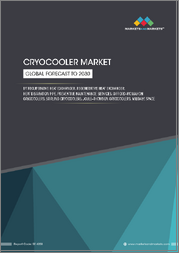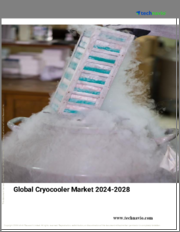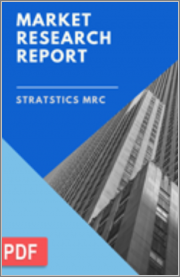
|
시장보고서
상품코드
1686249
극저온 냉동기 시장(2025-2030년) : 시장 점유율 분석, 산업 동향 및 통계, 성장 예측Cryocooler - Market Share Analysis, Industry Trends & Statistics, Growth Forecasts (2025 - 2030) |
||||||
극저온 냉동기 시장 규모는 2025년에 34억 7,000만 달러로 추정되며, 예측 기간(2025-2030년) 동안 CAGR 6.4%로 성장하여 2030년에는 47억 3,000만 달러에 달할 것으로 예측됩니다.

주요 하이라이트
- 극저온 냉동기는 극저온에 도달하기 위해 능동적으로 냉각을 수행하는 장치입니다. Cryogenic Society of America Inc.에 따르면, 크라이오쿨러 또는 극저온 냉동기는 약 -150℃에서 능동적으로 냉각할 수 있도록 설계되었습니다. 밀폐된 튜브 내의 가스 흐름을 이용하여 온도를 흡수하고 외부로 방출합니다. 이 장치에는 일반적으로 헬륨 또는 혼합 가스가 사용됩니다. 이러한 장치는 일반적인 극저온 유체를 대체할 수 있는 특정 저온에서 냉동 기능을 제공합니다. 극저온 냉동기에는 스털링, 펄스관, 기포드-맥마흔(GM), 줄-톰슨 등 다양한 유형이 있습니다.
- 극저온 냉동기의 채용을 촉진하는 주요 요인 중 하나는 야간 투시 시스템에 설치된 IR 센서를 극저온에서 유지하기 위해 군 및 방위 산업에서 채용이 확대되고 있다는 점입니다. 각국의 방위력 강화에 따라 야간 투시장치의 사용은 지난 몇 년간 크게 증가하고 있습니다. 또한 각국은 신기술을 채택하기 위해 군사비를 늘리고 있습니다. SIPRI에 따르면 2023년 세계 군사비는 2조 4,400억 달러에 이르렀으며 지난 수십년 동안 최고 금액을 기록하였습니다.
- 게다가 적외선 카메라와 가시 카메라의 냉각 필요성은 소형 극저온 냉동기 시장에 기회를 창출하고 있습니다. 냉동기로 냉각되는 고성능 적외선 카메라는 여전히 중요 용도로 사용되고 있습니다. 2024년 2월, Prama India는 인도 정부의 첨단컴퓨팅개발센터(C-DAC)과 제휴하여 현지 생산과 기술 혁신 능력을 강화했습니다. 이 파트너십은 기술 이전(TOT) 협정에 의해 촉진되어 열화상 카메라의 제조, 마케팅, 지원을 추진하는 것을 목적으로 하고 있습니다.
- 가스의 액화나 극저온 보존 등의 공업 프로세스 및 초전도 자기 에너지 저장(SMES) 시스템 등의 에너지 용도에서는 극저온 냉동기의 수요가 확대되고 있어 시장의 성장을 한층 더 추진하고 있습니다. 또한, 우주 탐사나 인공 위성의 배치가 확대되고 있어 적외선 센서나 기타 부품의 냉각에 필요한 극저온 냉동기의 수요가 증가하고 있습니다. 예를 들어, 극저온 컴포넌트와 시스템의 주요 개발 기업인 Creare는 NASA로부터 새로운 계약을 획득했습니다.
- 하지만, 기존의 극저온 냉동기의 기술적 문제는 시장의 성장에 있어 몇 가지 과제가 되고 있습니다. 기존 극저온 냉동기는 마찰에 의해 마모되는 부품으로 인해 유지보수가 필요하며 따라서 신뢰도가 높은 냉각 솔루션을 필요로 하는 잠재적인 사용자는 기피할 가능성이 있습니다.
- 게다가 고인플레이션과 원재료 및 제조 비용의 상승은 극저온 냉동기의 제조 비용에 영향을 미칠 가능성이 있습니다.
극저온 냉동기 시장 동향
최대 최종 사용자 부문은 헬스케어
- 극저온 냉동기는 MRI 시스템, 냉동수술, 양자선 치료에 널리 응용되므로 헬스케어에서 큰 수요가 있습니다.
- 극저온 냉동기의 높은 입력 전력 소비는 단점으로 알려져 있습니다. 그럼에도 핵자기공명(NMR) 장비에서는 극저온 냉동기의 사용이 증가하고 있습니다. 2023년 12월, Bruker Corporation은 오하이오 주립 대학의 National Gateway Ultrahigh Field NMR 센터에 1.2기가헤르츠(GHz) NMR 시스템을 설치하기로 발표했습니다.
- 게다가 의료기기의 대두도 시장 성장의 기회를 낳을 것으로 보입니다. 인도에서는 의료연구협회(ICMR)와 인도공과대학(IIT)가 협력하여 IIT에 ICMR을 설립하기로 합의했습니다. 게다가 2024-2025년도 중간 예산에서는 의약품 및 헬스케어 산업에 98,461크로르 루피(118억 5,000만 달러)가 할당되었습니다.
- 인도에서는 2025년까지 Jan Ausadhi 프로그램과 항결핵 캠페인 확대를 목표로 Ayushman Bharat 이니셔티브를 확대하고 있습니다. 이 또한 극저온 냉동기 시장의 성장을 뒷받침하고 있습니다.
- 게다가 극저온 보존(세포에서 조직에 이르기까지 생물학적 실체를 극저온에서 냉각하여 보존하는 방법)에서 극저온 냉동기는 중요한 역할을 하고 있습니다. 저온 생물학 분야 중에서도 특히 세포나 조직의 보존에서는 현저한 진보가 일어나고 있습니다. T세포와 같은 최첨단 면역세포 치료 및 동물과 식물 모두의 유전자 은행 설립 등 다양한 분야에 걸쳐 저온 생물학은 광범위하게 채용되고 있습니다.
- IARC의 '세계 암 보고'에 따르면 암 예방과 치료 분야의 끊임없는 진보에도 불구하고 세계 암 부담은 꾸준히 증가하고 있으며, 신규 환자수는 2018년부터 2040년 사이에 50% 증가할 것으로 예측되고 있습니다. 또한 WHO에 따르면 2040년까지 세계의 신규 암 환자수는 2,988만명, 2050년까지 3,528만명에 이를 것으로 예측되고 있습니다.
북미가 가장 큰 점유율을 차지할 전망
- 북미는 군수산업과 헬스케어 산업에 대한 투자 증가로 극저온 냉동기 시장 도입을 크게 견인하고 있습니다.
- 게다가 미국 정부의 우주기관은 혁신적인 극저온 냉각 기술 도입에 많은 연구 개발 자금을 투자했습니다. 예산과 제반 문서에 제시된 미국의 핵전력계획은 2023-2032년 기간에 7,560억 달러를 요할 것으로 예측되고 있으며, 이는 2021-2030년 기간보다 1,220억 달러가 많은 금액입니다.
- 이 지역의 헬스케어 산업에서 극저온 냉동기의 요구가 높아지고 있으며 양자선 치료, 냉동수술, MRI 시스템, 병원 내 산소 액화 등으로 극저온 냉동기가 폭넓게 이용되고 있습니다. 이 지역은 고형 종양, 폐암, 백혈병의 치료를 목적으로 한 가장 저명한 그룹을 중심으로 신규 암 치료제나 극저온 냉동기 등 급속하게 진화하는 기술의 중요한 개발 지역입니다.
- 게다가 이 지역의 극저온 냉동기 시장은 극저온 냉동기가 주로 암 치료의 양자선 치료에 사용되고 있기 때문에 성장하고 있습니다., 0-14세의 소아에게 뇌종양은 암 관련 사망의 중대한 원인입니다.
- 미국에서는 암이 사인의 제2위를 차지하고 있습니다.
- 극저온 냉동기는 야간 투시 시스템, 위성 감시 시스템, 미사일 유도 시스템 등에 탑재되는 IRIR 센서를 극저온에서 유지합니다.
- NASA는 경기장 크기의 풍선을 이용한 우주 연구에 착수했습니다. 이 임무에서는 ASTHROS를 2023년 12월에 남극 대륙에서 발사하였습니다. ASTHROS가 장착된 풍선에는 관측 장치와 경량 망원경이 장착되어 있으며 ASTHROS를 통해 지구에서 보이지 않는 빛의 파장을 관찰합니다. NASA는 전력을 공급하는 극저온 냉동기를 사용하여 관측장치를 냉각시키고 초전도 검출기를 -268.5℃ 부근에서 유지합니다.
극저온 냉동기 시장 개요
극저온 냉동기 시장에는 Sumitomo 및 Barry Automation Inc.를 비롯한 여러 주요 기업이 존재하며, 다른 경쟁업체와 함께 적당히 세분화된 시장에서 우위를 차지하기 위해 노력하고 있습니다. 이러한 기업들은 제품 혁신, 투자, 인수, 전략적 파트너십 등 강력한 경쟁 전략을 채택하여 시장에서의 존재감과 경쟁력을 유지하고 있습니다. 조사 기간 동안 시장 내 경쟁업체 간의 경쟁 관계는 중간 수준에서 높은 수준을 보였습니다.
기타 혜택
- 엑셀 형식 시장 예측(ME) 시트
- 3개월간 애널리스트 지원
목차
제1장 서론
- 조사의 전제조건과 시장 정의
- 조사 범위
제2장 조사 방법
제3장 주요 요약
제4장 시장 인사이트
- 시장 개요
- 업계의 매력도 - Porter's Five Forces 분석
- 공급자의 협상력
- 구매자의 협상력
- 신규 참가업체의 위협
- 대체품의 위협
- 경쟁 기업간 경쟁 관계의 강도
- 산업 밸류체인 분석
- 기술 스냅샷
- 주요 거시경제 동향이 시장에 미치는 영향
제5장 시장 역학
- 시장 성장 촉진요인
- 신흥 경제 국가에서 의료 및 헬스케어 서비스 성장
- 액화 천연가스 생산 증가
- 시장 성장 억제요인
- 극저온 냉동기의 성능 제약
제6장 시장 세분화
- 최종 사용자 산업별
- 우주
- 헬스케어
- 군사
- 상업
- 수송
- 기타 최종 사용자 산업별
- 지역별
- 북미
- 유럽
- 아시아태평양
- 세계 기타 지역
제7장 경쟁 구도
- 기업 프로파일
- Sumitomo Heavy Industries Limited
- Sunpower Inc.(AMETEK Inc.)
- Ricor Systems
- Eaton Corporation PLC
- Cryomech Inc.(Bluefors OY)
- Chart Industries Inc.
- Janis Research Company LLC
- Advanced Research Systems Inc.
- Air Liquide Advanced Technologies
- Stirling Cryogenics BV
- Northrop Grumman Corporation
- Thales Group
제8장 투자 분석
제9장 시장의 미래
CSM 25.04.25The Cryocooler Market size is estimated at USD 3.47 billion in 2025, and is expected to reach USD 4.73 billion by 2030, at a CAGR of 6.4% during the forecast period (2025-2030).

Key Highlights
- A cryocooler is a device that provides active cooling to reach cryogenic temperatures. According to the Cryogenic Society of America Inc., a cryogenic cooler or a cryocooler is designed to allow active cooling at about -150 °C. It uses the flow of gas inside closed tubes, which absorbs the temperature and radiates it outside. The device generally uses helium or a mixture of gases. These devices produce refrigeration at a specific low temperature that can replace normal cryogenic fluids. There are many types of cryocoolers, including Stirling, pulse tube, Gifford-McMahon (GM), and Joule-Thomson.
- One of the major factors driving the adoption of cryocoolers is its growing adoption across the military and defense industries to maintain cryogenic temperatures for IR sensors installed in night-vision-based systems. The use of night vision devices has significantly increased in the last few years as countries advance their defense capabilities. Moreover, countries are increasing their military spending to adopt new technologies. According to SIPRI, military spending worldwide amounted to USD 2.44 trillion in 2023, the highest amount in several decades.
- Furthermore, the cooling of infrared and visible cameras continues to provide opportunities for small cryocoolers. While recent years have witnessed a shift from cooled to uncooled IR cameras, there is still significance for high-performance infrared imagers cooled by small Stirling cycle cryocoolers. For instance, in February 2024, Prama India partnered with the Indian government's Centre for Development of Advanced Computing (C-DAC) to bolster local production and innovation. This partnership, facilitated by a transfer of technology (TOT) agreement, centers on advancing thermal camera manufacturing, marketing, and support. It signifies Prama India's stride in leveraging technology for advanced thermal camera R&D. Such government initiatives in advanced technology may further propel the market's growth.
- The need for cryocoolers in industrial processes, such as liquefaction of gases and cryogenic preservation, as well as in energy applications like superconducting magnetic energy storage (SMES) systems, is expanding, further propelling the market's growth. Also, the expanding activities in space exploration and the deployment of satellites, which rely on cryocoolers for cooling infrared sensors and other components, are significant drivers. For instance, Creare, a significant developer of cryogenic components and systems, received a new contract from NASA. The SBIR Phase II award from NASA Shared Services Center is expected to fund further expansion of a 10 K multi-stage cryocooler with very low vibration.
- Moreover, technical problems with traditional cryocoolers present several challenges to the market's growth. Traditional cryocoolers often have moving parts, such as pistons and compressors, which can wear out over time, leading to frequent maintenance and reduced reliability. This can deter potential users who require highly reliable cooling solutions for critical applications. Also, some traditional cryocoolers have relatively low thermodynamic efficiency, resulting in higher power consumption. This inefficiency can be a significant drawback in applications where energy efficiency is essential, such as in space missions or portable medical devices.
- Additionally, high inflation and rising costs of raw materials and manufacturing can impact the production costs of cryocoolers. This may affect pricing and profit margins, potentially influencing the market's growth. Furthermore, increasing focus on environmental sustainability and regulations related to energy efficiency can drive demand for more efficient cryocoolers that consume less power and have a lower environmental impact.
Cryocooler Market Trends
Healthcare to be the Largest End-user Vertical
- Cryocoolers are in significant demand in healthcare due to their widespread application in MRI systems, cryosurgery, and proton therapy. They are used to keep the superconducting magnets in this medical equipment cool. The studies and developments on cryocoolers have enhanced their acceptance in the healthcare industry for various applications.
- The high input power consumption of cryocoolers is claimed to be a limitation. However, the benefits of using cryocoolers in healthcare exceed the drawbacks. The use of cryocoolers in magnetic resonance image (MRI) and nuclear magnetic resonance (NMR) equipment is increasing in the medical field. For instance, in December 2023, Bruker Corporation, a significant provider of nuclear magnetic resonance (NMR) spectroscopy solutions for life and materials research, announced the installation of a 1.2 gigahertz (GHz) NMR system at the National Gateway Ultrahigh Field NMR Center at the Ohio State University. Such initiatives may further create demand for cryocoolers in the healthcare segment.
- In addition, the rise in medical machines would create an opportunity for the market's growth. The Indian Council of Medical Research (ICMR) and Indian Institutes of Technology (IITs) cooperated in establishing 'ICMR at IITs' by establishing centers of excellence (CoE) for Make in India product development and commercialization in the medical devices space. According to IBEF, FDI inflows into the medical and surgical appliances industry stood at USD 3.26 billion between April 2000 and December 2023. Furthermore, in the Interim Budget 2024-25, INR 98,461 crore (USD 11.85 billion) was allocated for the pharmaceutical and healthcare industry.
- Furthermore, the country is scaling up the Ayushman Bharat initiative, aiming to expand the Jan Ausadhi program and anti-TB campaign by 2025. This is also aiding in the growth of the cryocooler market. Such increased budget allocations may help in the growth of the healthcare industry and, thereby, the market. Robust infrastructure, access to diagnostics, comprehensive healthcare policy, and tax incentives are some expectations of the healthcare industry from this budget.
- In addition, cryocoolers play a crucial role in cryopreservation, a method that conserves biological entities, ranging from cells to tissues, by chilling them at extremely low temperatures. The field of cryobiology, especially in cell and tissue preservation, has seen significant advancements. This progress has led to cryobiology's extensive adoption, spanning diverse fields like reproductive medicine, hematopoietic stem cell treatments for cancer, cutting-edge immune cell therapies like CAR T-cells, and the establishment of gene banks for both animals and plants.
- According to the IARC's World Cancer Report, despite constant progress in cancer prevention and treatment, the global cancer burden kept growing, as the number of new cases is anticipated to increase by 50% between 2018 and 2040. Furthermore, according to the WHO, new global cases of cancer are anticipated to be recorded at 29.88 million by 2040 and 35.28 million by 2050. Such factors are expected to drive the demand for cryocoolers.
North America is Expected to Hold the Largest Share
- North America is significantly driving the adoption of cryocoolers in the market due to rising investment in the military and healthcare industries. According to SIPRI, the United States led the ranking of the countries with the highest military spending in 2023, with USD 916 billion dedicated to the military.
- Furthermore, government space organizations in the United States invested significant research and development funds in introducing innovative cryogenic cooling technology. This will help the country's space industry grow in the coming years. According to the US Congressional Budget Office, the plans for US nuclear forces, as outlined in the FY 2023 budget and supporting documents, are projected to cost USD 756 billion over the 2023-2032 period, which is USD 122 billion more than the 2021-2030 period.
- In the healthcare industry, the rising need for cryocoolers in the region is attributed to their extensive utilization in proton therapy, cryosurgery, MRI systems, and the liquefaction of oxygen in hospitals. The area is a significant developer of new cancer drugs and rapidly evolving technologies, such as cryocooler devices, with the most prominent groups aimed at treating solid tumors, lung cancer, and leukemia.
- Additionally, the cryocooler market in the region has been escalating as cryocoolers are primarily used for proton therapy in cancer treatment. Proton therapy for lung and brain cancers has proven to be a suitable treatment for patients whose cancer is limited to the local area. Brain tumors are the significant cause of cancer-related death among children aged 0-14. The upsurge in the cases of the cancers noted above in the region may drive the demand for proton therapy, thereby driving the market's growth. According to the National Association of Proton Therapy, 42 proton therapy centers treat patients in the United States.
- Cancer is the second leading cause of death in the United States. According to the American Cancer Society, in 2024, it was estimated that there would be over 972 thousand new cancer cases among women in the United States. The source also estimated that there will be around 125,070 deaths from lung and bronchus cancers in the same year.
- Cryocoolers maintain cryogenic temperatures for IRIR sensors installed in night vision-based systems, satellite-based surveillance, and missile guidance. The growing demand for cryocoolers across North America's military and surveillance industries has been boosting the cryocooler market in the region.
- NASA has started working on studying the cosmos using a stadium-sized balloon. The mission, ASTHROS, was launched in December 2023 from Antarctica. The balloon carrying ASTHROS will carry the instrument and a lightweight telescope. ASTHROS will observe wavelengths of light invisible from Earth. NASA will use a cryocooler supplied with electricity to cool the tools and keep superconducting detectors near -268.5 °C.
Cryocooler Market Overview
The cryocooler market is home to multiple key players, including Sumitomo and Barry Automation Inc., alongside other contenders, all striving for prominence within this moderately fragmented market space. These companies have embraced potent competitive strategies, such as product innovations, investments, acquisitions, and strategic partnerships, to maintain their relevance and competitive edge in the market. During the study period, the competitive rivalry within the market exhibited a moderately high level of intensity.
Additional Benefits:
- The market estimate (ME) sheet in Excel format
- 3 months of analyst support
TABLE OF CONTENTS
1 INTRODUCTION
- 1.1 Study Assumptions and Market Definition
- 1.2 Scope of the Study
2 RESEARCH METHODOLOGY
3 EXECUTIVE SUMMARY
4 MARKET INSIGHTS
- 4.1 Market Overview
- 4.2 Industry Attractiveness - Porter's Five Forces Analysis
- 4.2.1 Bargaining Power of Suppliers
- 4.2.2 Bargaining Power of Buyers
- 4.2.3 Threat of New Entrants
- 4.2.4 Threat of Substitute Products and Services
- 4.2.5 Intensity of Competitive Rivalry
- 4.3 Industry Value Chain Analysis
- 4.4 Technology Snapshot
- 4.5 Impact of Key Macroeconomic Trends on the Market
5 MARKET DYNAMICS
- 5.1 Market Drivers
- 5.1.1 Growing Medical and Healthcare Services in Developing Economies
- 5.1.2 Increasing Production of Liquefied Natural Gas
- 5.2 Market Restraints
- 5.2.1 Performance Constraint of Cryocoolers
6 MARKET SEGMENTATION
- 6.1 By End-user Vertical
- 6.1.1 Space
- 6.1.2 Healthcare
- 6.1.3 Military
- 6.1.4 Commercial
- 6.1.5 Transportation
- 6.1.6 Other End-user Verticals
- 6.2 By Geography
- 6.2.1 North America
- 6.2.2 Europe
- 6.2.3 Asia-Pacific
- 6.2.4 Rest of the World
7 COMPETITIVE LANDSCAPE
- 7.1 Company Profiles
- 7.1.1 Sumitomo Heavy Industries Limited
- 7.1.2 Sunpower Inc. (AMETEK Inc.)
- 7.1.3 Ricor Systems
- 7.1.4 Eaton Corporation PLC
- 7.1.5 Cryomech Inc. (Bluefors OY)
- 7.1.6 Chart Industries Inc.
- 7.1.7 Janis Research Company LLC
- 7.1.8 Advanced Research Systems Inc.
- 7.1.9 Air Liquide Advanced Technologies
- 7.1.10 Stirling Cryogenics BV
- 7.1.11 Northrop Grumman Corporation
- 7.1.12 Thales Group


















